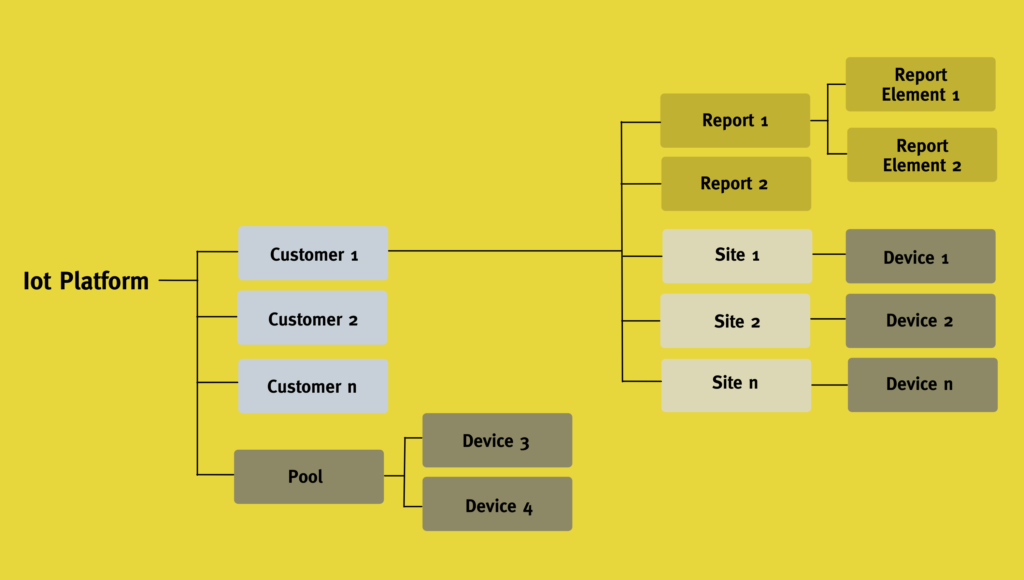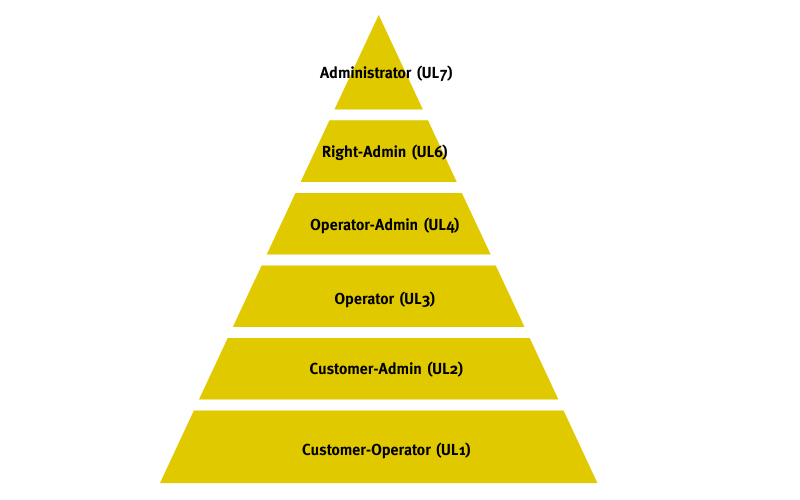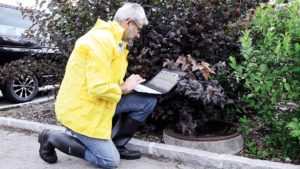At the latest when several people work with the IoT platform or you manage devices and data of different customers, customer management is inevitable. After all, every customer should only see his or her data. This is often referred to as tenant management – i.e. the management of the “tenants”.
Not only for the administration of different customers and users, but also with regard to the devices, the IoT platform from Microtronics offers some helpful functions that make your life easier.
This article gives an overview of the structure of the levels and the elements for the administration of customers and data. This knowledge also helps you with the assignment of rights.
Detailed description of all aspects of customer / tenant management
The IoT platform distinguishes between main and customer level.
On the main level you manage your customers or clients. All settings on the main level, as well as everything you see here, apply to all data on the server. For example, you get an overview of the alarms of all customers. In the statistics you can see the consumption of all your customers.
The sites and reports of the respective customer or client are located on the customer level. Here, the customer can manage their devices and create their own reports and statistics. Some areas already found on the main level are repeated here. At this point, however, only information on the respective customer is displayed. For example, the customer gets an overview of his alarms. In the statistics, the customer sees the consumption of his sites and devices.
Data from sites cannot be shared between two customers.

What is a customer?
A customer (sometimes also called client, project or tenant) is a closed area in which the sites and reports are created. This area is only accessible to the respective customer. Data can therefore not be shared between two customers.
What is a user?
A user logs on to the IoT platform. For this reason, users need at least the following properties:
- Username
- Password
- E-mail *
Users are distinguished in two ways:
- Natural or technical persons
- On the basis of the user levels
Natural persons or technical persons
So-called “technical persons” or users can only access technical interfaces (for example REST API).
Natural persons are subject to the GDPR. Therefore, the email address is mandatory so that the GDPR confirmation request can be sent by the system. Natural persons can access both the web interface and the REST API. Read more in the description of the GDPR-compliant IoT platform.

User level UL7 has the most rights. Only very few users have this powerful user level. In contrast, there will be very many users with user level UL1, as they have only very limited rights.
Customer Operator (UL1)
This user level is assigned to exactly one customer and thus has exclusive access to the data of exactly this customer. Only reading rights are available. This means that no changes (new sites or reports, adjustments of settings, …) can be made.
Customer Admin (UL2)
This user level is assigned to exactly one customer and thus has exclusive access to the data of exactly this customer. Read and write permissions are available. This means that changes (new sites or reports, adjustments of settings, …) can be made.
Furthermore, new users from level 1 can be created with this user level. Depending on the platform configuration, the installation of users may also be released from level 2.
Operator (UL3)
This user has access to the main level of the platform. Thus, he can have access to more than one client. The activation of customers is carried out by a user with user level 6 or 7.
This user has reading rights. This means that no changes (new sites or reports, adjustments of settings, …) can be made.
Operator Admin (UL4)
This user has access to the main level of the platform. Thus, he can have access to more than one client. The activation of customers is carried out by a user with user level 6 or 7.
Read and write permissions are available to this user. This means that changes (new sites or reports, adjustments of settings, …) can be made. The user can also create new customer. Customers that he has created himself are automatically activated for him by default.
This user can also manage the users with user level 1 and 2 of his activated customers.
Rights Admin (UL6)
This user has the same rights as the operator admin (UL4).
As an extended right, this user can access all customers and manage user levels 3 and 4. This means creating new users and changing the customer assignment of user levels 3 and 4.
Furthermore, this user can manage the app store and thus distribute updates globally or install new applications on the IoT platform.
Administrator (UL7)
This user has the same rights as the operator admin (UL6). In addition, the user has the extended right to adjust the settings of the IoT platform. He can set default values for number, time and date formats, add new languages and view change logs.
Summary user level:
- User levels UL1 and UL2 only have access to one customer
- User levels UL3 and UL4 have access to a restricted list of customers
- User levels UL6 and UL7 have access to all customers
- User levels UL1 and UL3 have read-only access
What is a site?
The site is the digital twin of the device on the platform. All application-specific properties and data are stored on this object (configurations, application (DLO), historical measurement data, applog, …).
A site is always assigned a maximum of one device.
What is a device?
The device is the object that sends data to a site or receives parameters from the site.
If a device requires service, the device connected to the site can be exchanged in the platform. With the next synchronisation, all settings, the application etc. are sent to the device. The device is now recording data for this site. This means that data can be recorded without interruption, even when devices need to be serviced.
What is a report?
Reports are the possibility to present data visually in different ways. For example, the data can be displayed in diagrams, graphs or tables over time. Other options are a map display or the display of the last measured values.
What is the (device) pool?
In the pool you can see all your devices that are not currently assigned to a customer or site.
Conclusion
The customer management structure of the IoT platform enables you to manage customers and users extensively. The rights provide for a fine granulation of the powers of the respective users.
Customer management provides you with a powerful tool in the administration and management of your users, clients and projects.

